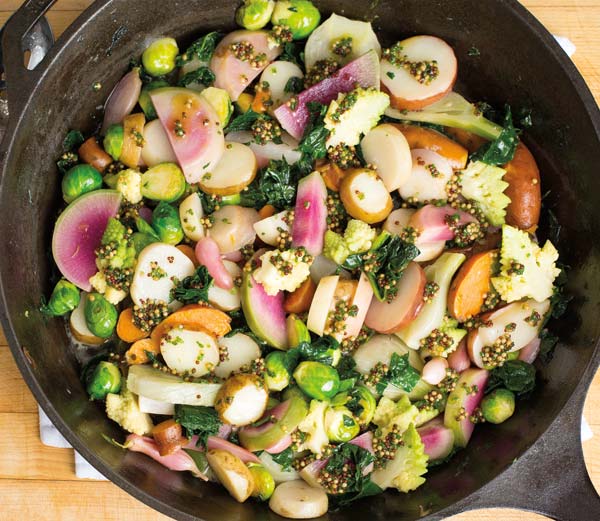Ingredients
For this dish, I always choose seasonal vegetables supplied by local farmers. As the growing season progresses, you can substitute such items as crunchy asparagus, delicious roasted zucchini, oven-dried tomatoes (or fresh heirlooms) and sweet corn. Various types of peppers, onions, garlic scapes and herbs are other options. The possibilities are endless! Here’s what I used for a late winter/early spring vegetable medley:
- Turnips: Butter “braised” in a pan with butter and water until tender
- Brussels Sprouts: Lightly seared in butter, oil and water until tender
- Radishes: Butter “braised” in a pan with butter and water until tender
- Lacinato Kale: Blanched, shocked and cut (you can use any type of green such as Swiss chard or spinach)
- Potatoes: Simmered in a flavorful liquid and cut (or “confit” them in extra virgin olive oil)
- Romanesco: Blanched and shocked
Directions
- The trick to this dish is careful preparation of all the different types of vegetables. If you simply throw everything into a pot of boiling water, you’ll end up with a tasteless hodgepodge whose degrees of doneness range from raw to mush. This is where a little technique goes a long way toward color and flavor.
- Radishes and turnips are best “braised” in a butter, water and salt mixture until tender. Kale and other types of hearty greens are best when they’re blanched in salted boiling water and then shocked. Potatoes are amazing when they’re “confit” in extra virgin olive oil that has been flavored with spices such as chili flake, fennel seed, cumin seed and coriander. (This can be done atop the stove or in the oven; the oil just needs to start out at room temperature; there are lots of online recipes.) They can just as easily be simmered in a flavorful water mix until tender. Romanesco and other types of cauliflowers are best blanched and shocked. They can also be roasted for a deeper flavor.
- Once all the vegetables are prepared separately, they can very quickly be warmed up, seasoned and finished with vinaigrette, salsa verde or herb puree. The trick here is to add the vegetables in layers, taking into consideration the amount of heating and cooking time that will be needed. And, there’s no need to transfer the veggies to a serving dish. The cast iron beautifully goes from the stove to the table.
Vegetable Cast Iron with Pickled Mustard Seed “Vinaigrette”


Leave a Reply